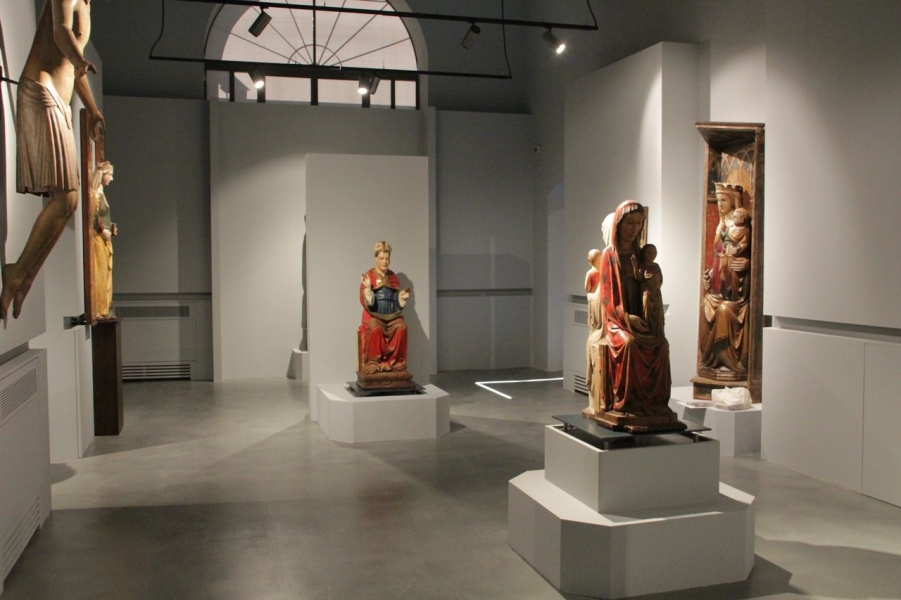Il Munda ed il plastico della Città
per person
Il Museo nazionale d’Abruzzo (abbreviato in MUNDA dal 2015) è il principale museo della regione. Storicamente ospitato nelle 41 sale del Forte spagnolo dall’apertura nel 1951, è stato chiuso in seguito al terremoto dell’Aquila del 2009; dal dicembre 2014 il museo è in gestione al Polo museale dell’Abruzzo. La collezione principale del museo è stata resa accessibile nei locali dell’ex mattatoio (Piazzale Tornimparte nel Borgo Rivera) a partire dal dicembre 2015. L’area, a forte connotazione turistico-monumentale, è caratterizzata dalla presenza della Fontana delle 99 cannelle e della chiesa di San Vito alla Rivera.
Occupa una superficie di oltre 4.000 m², di cui circa la metà recuperati e accessibili al pubblico, ed è formato da un edificio principale (sede della collezione del museo nazionale d’Abruzzo) e da un nuovo fabbricato, ulteriormente suddiviso in due blocchi a livelli sfalsati, al cui interno trovano posto le strutture accessorie al museo, una sezione uffici ed una sala congressi da 96 posti. Il padiglione principale si articola su 6 sale all’interno di 5 aree espositive.
Sala 1 Archeologia d’Abruzzo. Sala 2 le Madonne. Sala 3 – 4 Età Angioina – Età tardo Gotica e Rinascimento. Sala 5 – 6 i Francescani – Opere del Barocco aquilano.
All’interno del Munda è anche in esposizione la mappa dei beni culturale dell’Aquila è stata realizzata con un Plastico della città.
L’opera, che è realizzata a mano in scala 1:1000, riporta in chiave circolare con il perimetro delle mura urbiche per un’estensione di 3,5km quadrati. Sono stati riprodotto l’aspetto morfologico, urbanistico e paesaggistico del territorio, attraverso l’uso della cartografia tecnica che, con gli isolati in rilievo, accentuano la pianta della città. Il plastico mostra i principali monumenti religiosi e civili della città dell’Aquila con particolare attenzione a quelli già restaurati. Il plastico è definito working in progress in quanto aranno aggiunti altri modellini man mano che i cantieri saranno terminati e i monumenti restituiti alla città.
I modelli sono realizzati in 3D con i rilievi originali e sono stati stampati con l’utilizzo di una sostanza derivata del mais. Per realizzare tutto il plastico sono stati usati materiali ecocompatibili come legno muiltistrato e materiali riciclabili colorati con colori acrilici su base acquosa.
In un cassetto con una tavola estraibile è contenuta la leggenda del plastico.
La realizzazione del plastico è utile a visualizzare la stato della ricostruzione dei monumenti e palazzi sempre aggiornato. Il plastico è stato reso possibile grazie al progetto L’Aquila Città d’Arte, frutto dell’accordo tra Mibact e Comune dell’Aquila.
Il plastico è stato voluto da Lucia Arbace, direttore del Polo Museale d’Abruzzo e realizzata dalla società Creative.
Tutte le informazioni e i dettagli sono sul ricco sito www.beniculturali.it nella sezione MUNDA.
The Munda and the model of the City
The Abruzzo National Museum (abbreviated to MUNDA since 2015) is the region’s main museum. Historically it was located in the 41 rooms of the Spanish Fort since its opening in 1951. It was closed following the earthquake of L’Aquila in 2009; since December 2014 the museum is under the management of the Museum Centre of Abruzzo The museum’s main collection was made accessible on the premises of the former slaughterhouse (Piazzale Tornimparte in Borgo Rivera) from December 2015. The area, with a strong tourist-monumental connotation, is characterized by the presence of the Fountana delle 99 Cannelle (Fountain of 99 Water spouts) and the church of San Vito alla Rivera.
It occupies an area of over 4,000 m², of which about half are recovered and accessible to the public, and consists of a main building (seat of the collection of the National Museum of Abruzzo) and a new building, further subdivided into two blocks at staggered levels, inside which are placed the structures ancillary to the museum, an office section and a conference room with 96 seats. The main pavilion is divided into 6 rooms within 5 exhibition areas.
Sala 1 Archeologia d’Abruzzo. Sala 2 le Madonne. Sala 3 – 4 Età Angioina – Età tardo Gotica e Rinascimento. Sala 5 – 6 i Francescani – Opere del Barocco aquilano.
Room 1 Archaeology of Abruzzo. Room 2 the Madonnas. Room 3– 4 Angevin Age – Late Gothic Age and Renaissance. Room 5– 6 Franciscans – Works of the Baroque from Aquila.
A model of the city showing the map of the L’Aquila’s cultural heritage is also on display at the Munda
The work, which is handmade in 1:1000 scale, has a circular key with the perimeter of the city walls for an extension of 3.5 square kilometers. The morphological, urban and landscape aspect of the territory have been reproduced, through the use of technical cartography that, with the blocks in relief, accentuate the map of the city. The model shows the main religious and civil monuments of the city of L’Aquila with particular attention to those which have already been restored. The layout is defined as work in progress as other models will be added as work on the construction sites is completed and monuments are returned to the city.
The models are made in 3D with original reliefs and have been printed with the use of a substance derived from corn. The entire model was made using eco-friendly materials such as multi-layered wood and recyclable materials coloured with acrylic on water base.
The legend of the model is kept in a drawer with a removable board.
The creation of the model is useful in order to visualize the state of progress of the reconstruction of monuments and buildings as it is always being updated. The layout was made possible thanks to the L’Aquila Città d’Arte project, the result of the agreement between Mibact and the Town Hall of L’Aquila.
The model was designed by Lucia Arbace, director of the Museum Centre of Abruzzo and realized by the Creative company.
All information and details are on the rich website www.beniculturali.it in the MUNDA section.









